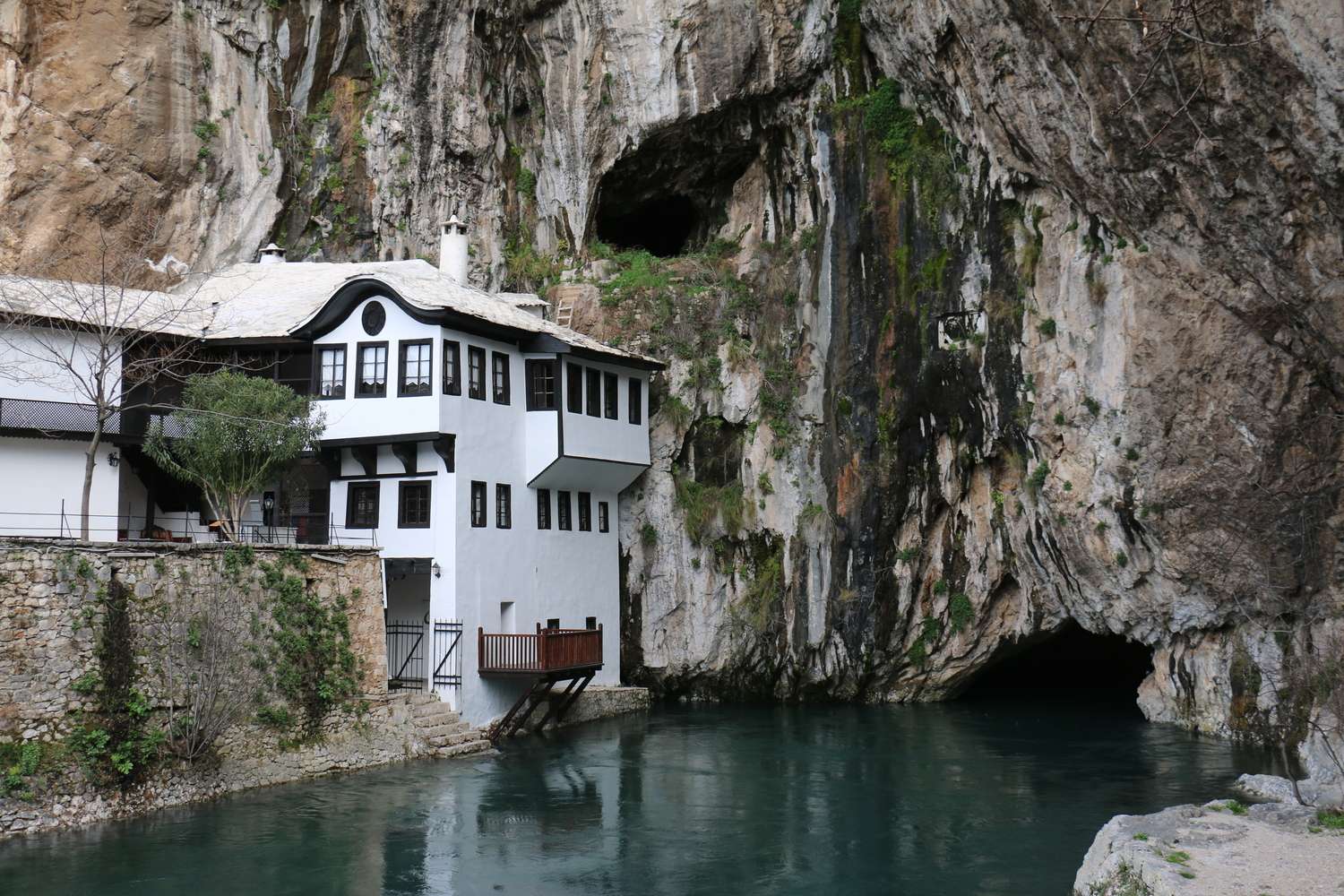
As I disembarked the bus from Split, Croatia, I couldn’t help but feel a mix of emotions. It was late in the evening, and I had made the last-minute decision to travel to Bosnia & Herzegovina via bus from Split in Croatia after my flight from Norwegian got cancelled due to their strike. I didn’t really know what to expect of Bosnia & Herzegovina, only knowing that it had been through a bloody civil war in recent history. But as soon as I arrived, I knew that I had made the right choice.
Despite the late hour, my kind host had arranged for a taxi to pick me up at the bus station, and before long I was settling into my hotel room in Mostar. I had originally planned to fly to Sarajevo and then make my way to Mostar by bus, but fate had other plans.
As I woke up to the mosque’s call to prayer, I couldn’t help but feel a sense of cultural immersion. The melodic sound wafting through my window made me feel as if I wasn’t in Europe anymore. I looked out the window at the city below and I could see the mix of Eastern and Western influences that make Bosnia & Herzegovina such a special place, the Ottoman-style architecture and the different cultures that seemed to permeate every aspect of the city.
Mostar is a city with a rich and diverse history that spans centuries. The city’s origins can be traced back to the Ottoman Empire, when it was established as a military stronghold in the 15th century. The Ottomans left their mark on the city in the form of stunning Islamic architecture, including the iconic Stari Most bridge. The bridge, which spans the Neretva River, was built in the 16th century and is one of the most recognizable landmarks in the city.

Mostar’s role in the Bosnian War (1992-1995)
It’s hard to write about Mostar without mentioning the Bosnian War between 1992-1995. The city’s strategic location, historical importance, and ethnic diversity made it a focal point of conflict and intense fighting. During the Bosnian War, Mostar was heavily damaged and the city’s iconic Stari Most bridge was destroyed.
Mostar was a symbol of the multicultural fabric of Bosnia and Herzegovina, with a population consisting of Bosniaks (Bosnian Muslims), Croats, and Serbs. However, as Yugoslavia disintegrated in the early 1990s, tensions escalated, leading to the outbreak of war.
In 1992, armed conflicts erupted between Bosniaks and Croats, who initially allied against the Serbs but later turned against each other. Mostar became a divided city, with the Bosniak-dominated east and the Croat-dominated west. The conflict in Mostar was marked by the intense shelling, sniping, and street-to-street fighting.
As you wander through the city, especially beyond the streets of the Old Town, you’ll notice many visible reminders of the Bosnian conflict, even after 30 years have passed. However, the bridge was rebuilt in the early 2000s and it now serves as a symbol of the city’s resilience and determination to preserve its heritage.








Best Places to Visit in and around Mostar
Mostar is home to a wide range of cool places to visit, each with their own unique charm and beauty. Here are some of the most popular and iconic attractions that should not be missed when visiting Mostar:
The Old Town: This historic district is a maze of narrow streets and alleys, lined with traditional Bosniak houses, monuments and landmarks. It’s a perfect place to wander around and get lost in the city’s rich culture and history.
Kujundziluk Old Bazaar: This charming bazaar offers a unique blend of Eastern and Western influences. You can find traditional crafts and souvenirs, as well as modern clothing and jewelry. Also, you can enjoy some delicious local food and drink.
Koski-Mehmed Pasha Mosque. Built in the 16th century, this mosque is a beautiful example of traditional Ottoman architecture. I highly recommend climbing the minaret for a breath-taking view of the city, including the iconic Stari Most bridge.
Kravice Waterfall: Located just a short drive from Mostar, the Kravice Waterfall is one of the most beautiful natural attractions in the area. The waterfall is located in a picturesque valley and is surrounded by lush greenery, especially if you are visiting during summer. The waterfall is about 100 ft high and visitors can take a dip in the natural swimming pool at the base of the falls. I visited in Kravice in March so the water was definitely too cold for me. The simplest way to reach the waterfall is to take a taxi from Mostar, which is roughly a 30-minute drive. Tell the driver to wait for you while you visit the waterfall. Bosnia is a cheap country, so it won’t cost you a fortune. The best time to visit the waterfall is during the summer months when the lush greenery is in its full blooming.
Blagaj Monastery: This beautiful Monastery is located at the source of the Buna River, and it’s surrounded by stunning natural beauty. The Monastery is built into a cliff face and it’s a perfect example of Ottoman-style architecture. The inside of the Monastery is decorated with frescoes and paintings that reflect the Islamic culture. The Monastery is a peaceful and serene place, which offers a great escape from the hustle and bustle of the city. I recommend all travelers to take a taxi to Blagaj Monastery as well since taxis don’t cost that much in Bosnia and it is the most convenient way to get around. Do this on the same day as you visit Kravice Waterfall and you will kill two birds with one stone.
Pocitelj is a fortified medieval town also located a short drive from Mostar. Pocitelj offers a glimpse into the region’s past, with a variety of historic buildings and monuments, including a fortress and a mosque. Visitors can explore the winding streets and alleys of the town, which are lined with traditional Bosniak houses and cobblestone paths. The alleys are steep and narrow while the streets are dotted with small courtyards and gardens, adding to the charming and peaceful atmosphere of the town.
Overall, there are so many things to see and do in Mostar and its adjacent areas, from immersing yourself in its rich history and culture, to enjoying the natural beauty of the surrounding area, it’s easy to fall in love with this fascinating city.





Food and Cuisine
One of the things that I enjoyed the most during my visit to Mostar was the local cuisine. The traditional dishes are heavily influenced by the Ottoman past and the blend of Eastern and Western cultures. I had some of my absolute favourite meals in Mostar, including cevapi (grilled meat skewers), burek (phyllo pastry filled with meat or cheese), and sarma (stuffed cabbage rolls) which I highly recommend. I found the best local dishes in the Old Town, where there are a variety of traditional restaurants and cafes. I also found some great street vendors and local markets that offered delicious traditional meals.
Getting to Mostar
I arrived in Mostar by bus from Split, Croatia, which was a convenient and affordable option. The bus ride took around 2 and a half hours, and the cost was around 25 euros. Mostar is also well-connected to other parts of Bosnia and Herzegovina and Europe by various modes of transportation.
By Bus: Mostar is well-connected to other parts of Bosnia and Herzegovina by bus, with regular services to cities like Sarajevo, Banja Luka, and Dubrovnik. Visitors can also find international bus services to destinations in Croatia and Montenegro. I took a bus from Mostar to Dubrovnik after my stay, it cost around 20 euros.
By Car: Mostar is located at the crossroads of major road networks in Bosnia and Herzegovina, making it easily accessible by car. Roads are not great though, so don’t expect a EU highway. Visitors can also rent a car in the city or at the airport. The cost of renting a car for a day is around 30 euros.
By Train: Visitors can take a train to Mostar from Sarajevo, which is the only train route to Mostar. The train takes around 2 hours, and the cost is around 15 euros one way.
Keep in mind that prices for transportation may vary depending on the season, and it’s always best to check for updates before planning your trip.
Final Thoughts
If you are visiting Croatia don’t overlook Mostar during your trip. It’s a great opportunity to take a break from the tourist hotspots and explore a unique and lesser-known destination. Consider dedicating a day or two to explore the city and its surroundings. And, lastly, don’t forget to visit the stunning Kravice waterfalls. It’s a must-see attraction in the area.



